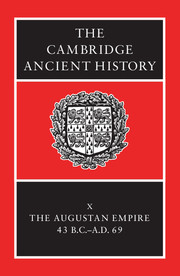5 - Tiberius to Nero
from PART I - NARRATIVE
Published online by Cambridge University Press: 28 March 2008
Summary
THE ACCESSION OF TIBERIUS AND THE NATURE OF POLITICS UNDER THE JULIO-CLAUDIANS
Political history explores the ways in which the men (and very occasionally women) who wielded power over others chose to exercise that power. In every system of government there are dozens, if not hundreds, of individuals who have to use their initiative about the exercise of power in particular circumstances, or about the best way to implement decisions taken by their superiors. But Rome under Augustus and his successors was a monarchy: every exercise of political power had ultimately to be answered for to the emperor. The emperor's authority could not publicly be challenged (anyone who successfully did so would become the new emperor). The political, history of the Principate is therefore primarily an account of the relationship between the reigning emperor and the other individuals and groups who played a role in public life. Although some of the political figures of the Julio-Claudian period were descended from families that had been powerful under the Republic, it does not follow that the ‘republican’ aristocracy still wielded independent power. Such men – like the ‘new men’ who were prepared to put their military or rhetorical skills at the service of the Caesars – had only as much power as the emperor allowed them, and only for as long as the emperor needed to make use of them. They had a place in public life only because, and insofar as, they had the princeps' favour; they were what in Latin would be called his amici, friends.
- Type
- Chapter
- Information
- The Cambridge Ancient History , pp. 198 - 255Publisher: Cambridge University PressPrint publication year: 1996
References
- 12
- Cited by

